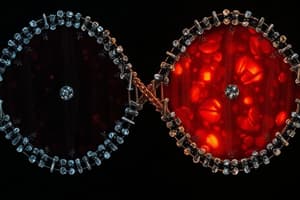Podcast
Questions and Answers
All cells are derived from pre-existing cells.
All cells are derived from pre-existing cells.
True (A)
What must happen to DNA before cell division?
What must happen to DNA before cell division?
DNA must be copied or replicated.
Which type of chromosomes do prokaryotes have?
Which type of chromosomes do prokaryotes have?
- Multiple linear chromosomes
- Ring-shaped chromosomes
- One circular chromosome (correct)
- No chromosomes
How many chromosomes do human body cells have?
How many chromosomes do human body cells have?
Duplicated chromosomes are called ______.
Duplicated chromosomes are called ______.
What is a karyotype?
What is a karyotype?
Which of the following processes is an example of asexual reproduction?
Which of the following processes is an example of asexual reproduction?
What occurs during cytokinesis?
What occurs during cytokinesis?
Match the following phases of the cell cycle with their descriptions:
Match the following phases of the cell cycle with their descriptions:
Mitosis occurs in prokaryotic cells.
Mitosis occurs in prokaryotic cells.
What forms to divide plant cells during cytokinesis?
What forms to divide plant cells during cytokinesis?
Flashcards are hidden until you start studying
Study Notes
Cell Division Overview
- All cells originate from pre-existing cells, ensuring continuity of life.
- New cells are created for growth and to replace damaged or aging cells.
- Cell division processes vary significantly between prokaryotes (bacteria) and eukaryotes (organisms such as protists, fungi, plants, and animals).
DNA and Cell Replication
- DNA contains instructions for building cell components; thus, it must be fully replicated for new cells.
- Each new cell inherits an identical set of DNA from its predecessor through replication before division.
Prokaryotic and Eukaryotic Chromosomes
- Prokaryotes possess a single, circular chromosome located inside the cell membrane.
- Eukaryotic cells store genetic material in chromosomes, with most species having between 10 and 50 chromosomes.
- Human cells contain 46 chromosomes, arranged as 23 homologous pairs.
- Chromosomes consist of tightly coiled DNA molecules, which condense into visible structures only during cell division; in non-dividing cells, DNA is in the form of chromatin.
Chromosome Structure and Karyotype
- DNA is wrapped around histone proteins to form nucleosomes, facilitating tight packing into chromosomes.
- Duplicated chromosomes during division are known as chromatids, connected by a centromere.
- A karyotype is an organized profile of an individual's chromosomes, highlighting 22 pairs of autosomes and one pair of sex chromosomes (XX for females and XY for males).
Methods of Reproduction
- Asexual reproduction produces two identical daughter cells from a single parent cell; examples include mitosis and binary fission.
- Sexual reproduction involves the combining of two gametes (egg and sperm) to form a unique zygote; meiosis exemplifies this process.
Prokaryotic Cell Division
- Prokaryotic cells undergo binary fission, cloning themselves to produce two identical cells.
- The process includes duplicating the single chromosome and forming a cell wall to separate the two copies.
The Cell Cycle Phases
- G1 (Gap 1): Primary growth phase where cells mature, increasing cytoplasm and organelle count, while performing routine metabolic functions.
- S (Synthesis): DNA replication phase where genetic material is copied in preparation for division.
- G2 (Gap 2): Secondary growth phase following DNA synthesis to prepare all necessary components and organelles for mitosis.
- M (Mitosis): Process of nuclear division.
- C (Cytokinesis): Division of the cell cytoplasm, resulting in two daughter cells.
Overview of Mitosis
- Mitosis is the eukaryotic nuclear division process and consists of four distinct stages.
- Not all cells divide; for example, certain neuron cells remain in a non-dividing state.
Stages of Mitosis
- Prophase: Chromatin condenses into visible chromosomes; spindle apparatus begins formation.
- Metaphase: Chromosomes align at the cell equator, attached to spindle fibers.
- Anaphase: Sister chromatids abruptly separate and are pulled to opposite cell poles.
- Telophase: Chromatids reach poles, nuclear envelopes reform, nucleoli reappear, and chromosomes de-condense back into chromatin.
Cytokinesis
- The final step that divides the cytoplasm into two daughter cells, each with an identical set of chromosomes.
- In plant cells, a cell plate forms at the equator; in animal cells, a cleavage furrow develops to separate the cells.
Daughter Cells and Mitosis
- The resulting daughter cells have the same chromosome number as both each other and the original parent cell.
- Although genetically identical, daughters are initially smaller and must grow through G1 in interphase to mature.
Uncontrolled Mitosis
- If mitotic processes are unregulated, it can lead to excessive cell division and the formation of cancerous tumors.
Studying That Suits You
Use AI to generate personalized quizzes and flashcards to suit your learning preferences.




